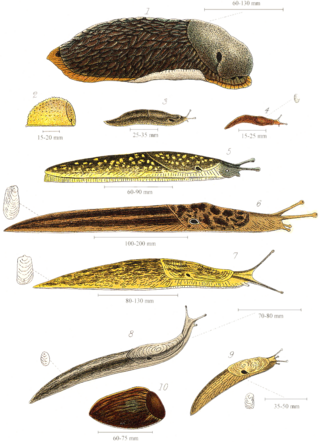
The northern bog lemming is a small North American lemming. It is one of two species in the genus Synaptomys, the other being the southern bog lemming.

The shelled slug, scientific name Testacella haliotidea, is a rarely seen, air-breathing, carnivorous land slug, a terrestrial gastropod mollusk in the family Testacellidae, the shelled slugs.
Arion lusitanicus, also known by its common name Portuguese slug, is a species of air-breathing land slug, a terrestrial pulmonate gastropod mollusk in the family Arionidae.

The Chinese box turtle, also known as the yellow-margined box turtle, or golden-headed turtle, is a species of Asian box turtle. Taxonomically, it is called Cuora flavomarginata.

Limax cinereoniger, the ash-black slug is a large species of air-breathing land slug in the terrestrial pulmonate gastropod mollusc family Limacidae, the keelback slugs. This is the largest land slug species in the world.

Malacolimax tenellus is a species of air-breathing land slug, a shell-less terrestrial gastropod mollusk in the family Limacidae.

Deroceras praecox is a species of small air-breathing land slug, a terrestrial pulmonate gastropod mollusk in the family Agriolimacidae.

The Kerry slug or Kerry spotted slug is a species of terrestrial, pulmonate, gastropod mollusc. It is a medium-to-large sized, air-breathing land slug in the family of roundback slugs, Arionidae.

The forest shrew is a species of shrew in the mouse shrew family, Soricidae. It is found in Lesotho, South Africa, and Eswatini. Its natural habitats include temperate forests, dry savanna, Mediterranean-type shrubby vegetation, and temperate grassland. The term "forest shrews" in the plural is sometimes confusingly used to collectively refer to a different genus, Sylvisorex.
Burnup's hunter slug is a species of land slug in the family Chlamydephoridae. It is endemic to South Africa, where it lives in forested foothill habitat.
Chlamydephorus is a genus of air-breathing land slugs, terrestrial pulmonate gastropod mollusks in the family Chlamydephoridae. It is the only genus within the family Chlamydephoridae.
Purcell's hunter slug, scientific name Chlamydephorus purcelli, is an endangered species of air-breathing land slug, a terrestrial pulmonate gastropod mollusk in the family Chlamydephoridae.

Eleutherocaulis haroldi, known as Purcell's hunter slug or the caterpillar slug, is a species of tropical land slug in the family Veronicellidae, the leatherleaf slugs. It was first formally named Laevicaulis haroldi in 1980.
Thapsia grandis is a species of air-breathing land snail or semi-slug, a terrestrial pulmonate gastropod mollusk in the family Urocyclidae.

Lehmannia marginata is a species of air-breathing land slug, a terrestrial pulmonate gastropod mollusk in the family Limacidae. Sometimes classified in the genus Limax, the species is distinct in its ecology, and its nearly transparent body. It is a medium-sized species, rarely exceeding 12 cm in body length. The body is fairly long and narrow, with a marked keel. The keel looks lighter than the remaining body against the darker innards.

Slug, or land slug, is a common name for any apparently shell-less terrestrial gastropod mollusc. The word slug is also often used as part of the common name of any gastropod mollusc that has no shell, a very reduced shell, or only a small internal shell, particularly sea slugs and semi-slugs.
The western falanouc is a rare mongoose-like mammal endemic to Madagascar. Until recently, the eastern falanouc was the only recognized species in the genus Eupleres. In 2010, Goodman and Helgen provided morphological evidence showing the two falanoucs are each a separate species and are found in separate geographical locations. E. major is larger and browner compared to E. goudotii and has a diet consisting mainly of invertebrates such as worms, snails, and slugs.











